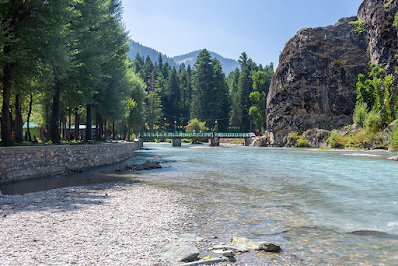Betaab valley
Betaab Valley, located in the northern Indian state of Jammu and Kashmir, is a picturesque tourist destination nestled amidst the breathtaking beauty of the Himalayan Mountains. Named after the Bollywood movie "Betaab," which was shot extensively in this region, the valley is renowned for its lush greenery, crystal-clear streams, towering mountains, and vibrant flora. Here's a detailed overview:
Betaab Valley is situated in the Anantnag district of Jammu and Kashmir, approximately 15 kilometers away from Pahalgam, another popular tourist destination in the region. It lies at an altitude of around 2,560 meters above sea level, offering visitors a cool and refreshing climate, especially during the summer months.
The valley is blessed with stunning natural scenery, characterized by verdant meadows, dense forests of pine and deodar trees, and snow-capped peaks that provide a dramatic backdrop. The Lidder River flows through the valley, adding to its charm with its crystal-clear waters.
Activities:Beautifull snow point
Trekking: Betaab Valley serves as a base for numerous trekking routes, catering to both amateur and experienced trekkers. The trails lead through picturesque landscapes, offering glimpses of local flora and fauna along the way.
Picnicking: The valley is an ideal spot for picnics and leisurely strolls amidst nature. Visitors can relax on the lush green meadows, enjoy a picnic by the riverbanks, or simply soak in the tranquil ambiance.Trekking
Photography: With its stunning vistas and breathtaking scenery, Betaab Valley presents ample opportunities for photography enthusiasts to capture the beauty of the Himalayas in all its glory. From snow-capped peaks to colorful blooms, every corner of the valley offers a perfect shot.Picnick
Best Time to Visit: The best time to visit Betaab Valley is during the summer months, from May to September, when the weather is pleasant and conducive to outdoor activities. The valley remains snow-covered during the winter months, making it inaccessible for tourists.
While there are limited accommodation options directly in Betaab Valley, visitors can find a range of hotels, resorts, and guesthouses in nearby Pahalgam, which is just a short drive away. These accommodations offer comfortable stays and often organize guided tours and activities in Betaab Valley.
Travel Tips:
It's advisable to carry warm clothing, even during the summer months, as temperatures can drop significantly, especially in the evenings.
Make sure to carry essential supplies such as water, snacks, sunscreen, and insect repellent, especially if you plan to indulge in outdoor activities.
Respect the local culture and customs, and follow any guidelines or restrictions in place, particularly in sensitive areas.
Betaab Valley, with its breathtaking natural beauty and plethora of outdoor activities, promises an unforgettable experience for nature lovers and adventure enthusiasts alike. Whether you're seeking tranquility amidst serene landscapes or seeking adrenaline-pumping adventures, this hidden gem in the Himalayas has something for everyone.Best Tourist Place




































